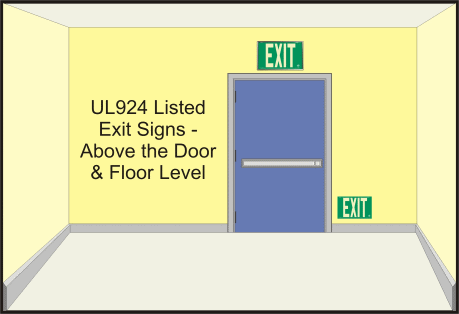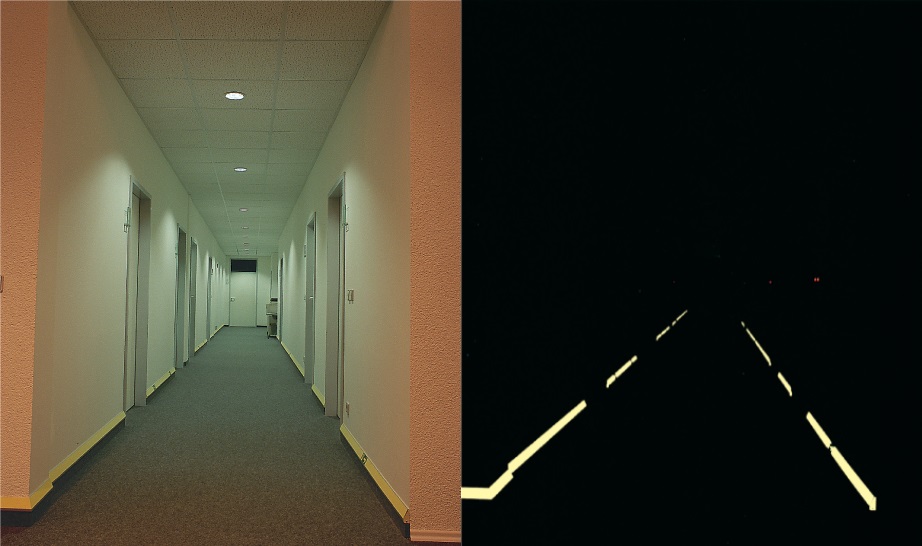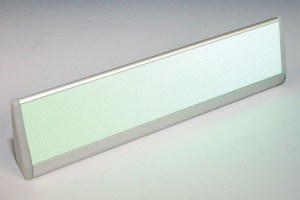Use Non-Electrical Photoluminescent Lighting
Save Lives, Energy & Money
- Unlimited Service Life
- Reliable & Effective in all Emergency & Hazardous Conditions
- Fail Safe Operation in all Light & Dark Evacuation Situations
- Works when Electrical Emergency Systems Fail
- Tested to the Same Performance Standards as Electrical Emergency Lighting
- Compliant with building & fire codes and NFPA 101 Life Safety Code
- Accepted and recommended by Life Safety, Fire Safety & Code Professionals
Contact EverGlow
Toll Free: (1) 866-744-4706
Telephone: (1) 704-841-2580
Email Us: This email address is being protected from spambots. You need JavaScript enabled to view it.
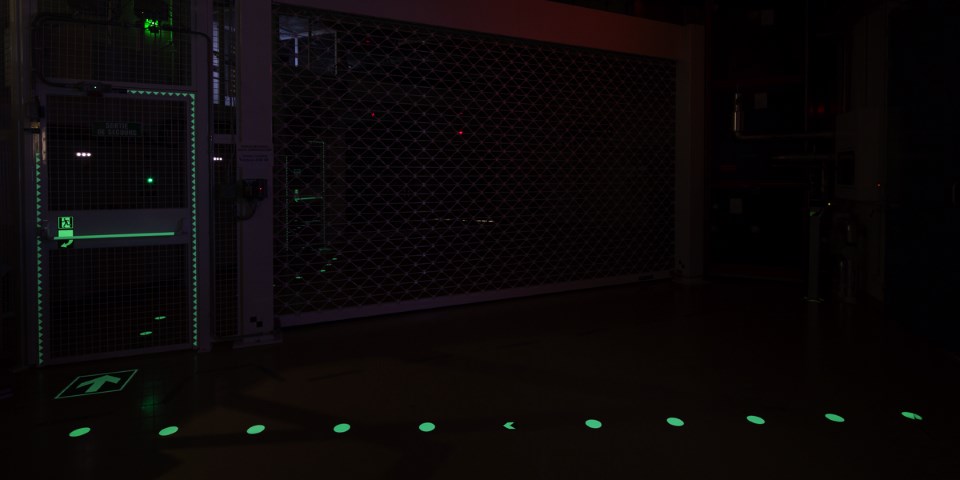
"...Photoluminescent exit signs have an unlimited service life and consume no energy."
-US Department of Energy
"The 2009 International Building & Fire Codes (Model Codes, IBC and IFC) and the NFPA 101 Life Safety Code Specify the Use of Non-Electrical Exit Path Markings in Many High Rise Occupancy Types."
-EverGlow
"The design of every building or structure intended for human occupancy shall be such that reliance for safety to life does not depend solely on any single safeguard."
-NFPA
Recognized Applications
All emergency lighting - non-electrical (photoluminescent, radioluminescent) & electrical (LED, fluorescent, incandescent, electroluminescent) - is tested and listed to the same performance standards. In North America, UL924 is the standard for exit signs and other (above the door) emergency lighting, and UL1994 is the standard for (floor level) luminous exit path markings. To supplement the UL performance standards, ASTM or ISO standards are often used.
Life safety depends upon occupants being able to evacuate interior spaces in three lighting levels:
- Normal Lighting (all lighting is available)
- Emergency Lighting (normal electrical lighting has failed, only emergency lighting is available)
- Complete Darkness (the failure of all electrical lighting systems; only non-electrical emergency lighting is available)
Applicable Standards & Codes:
- Buildings - IBC, IFC, Life Safety Code, DoD Unified Facilities Criteria, UL, most local building & fire codes
- Airplanes - FAA
- Trains - USDoT, FRA, RSAC, APTA
- Ships & Marine Work Platforms - US Navy, US Coast Guard, SOLAS, IMO
- Transportation Tunnels - USDoT, Metro Transit Authority

EverGlow Photoluminescent Emergency Lighting is specified to replace or supplement electrical lighting in many different applications.
Photoluminescent Emergency Lighting Components
- Exit Signs - located above the door and near floor level
- Exit Path Markings - located near floor level
- LLL (Low Level Lighting) - located near floor level
- Aisle Markers - Escape Markings - located near floor level
- Stair & Handrail Markers
- Perimeter Markers
- Door Frame & Hardware Markers
- Directional Markers
- NOT an EXIT Signs
Life safety depends on occupants being able to evacuate interior spaces in three lighting levels:
- Normal lighting (most evacuations occur in normal lighting)
- Emergency lighting
- Complete darkness (non-electrical emergency lighting is most valuable in this situation)
Emergency Lighting is designed to help evacuees safely & quickly find the exits in an emergency.
- Non-electrical emergency lighting is reliably visible in the dark
- Electrical emergency lighting is visible in light and dark conditions only if properly maintained
- Combination of electrical & non-electrical emergency lighting provide maximum safe egress
Emergency Lighting is most effective when located above the exit door and at floor level. Only floor level egress path markings are reliable & effective in smoke.
- Smoke obscures emergency lighting located near the ceiling
- Heat & sprinklers can neutralize electrical emergency lighting
- Floor level emergency lighting is more easily seen by evacuees crawling on the floor to escape smoke and heat
"In most facilities, the emergency lighting is insufficient and the exits should be marked better so they are easier to find, even though the facility meets local building and fire codes. Code requires only the minimum acceptable emergency lighting for the average facility."
-A Building & Fire Code Official
"Smoke injures or kills more people than heat from the fire. Yet most electrical emergency lighting is not designed to effectively help people find the exits or installed near floor level to be useful for evacuations in smoke."
-A Building & Fire Code Official
"...The (electrical) emergency lighting only becomes functional if there is a power outage, which was not the case in this fire ... The hallways were dark and hot because of the thick smoke. Investigation this morning shows that some (electrical) exit signs made of plastic melted from the heat (and smoke) that rose to the ceiling in the hallways."
-An Actual Fire Inspection Report
Why is Electrical Emergency Lighting Not Sufficient?
- Electrical emergency lighting is expensive to install and connect to the emergency lighting circuit
- Electrical emergency lighting requires reliable and regular maintenance
- Electrical emergency lighting has regularly been installed incorrectly
- Electrical emergency lighting has a short lifetime of typically less than 10 years in interior installations
- Electricity outages are common
- Battery, lamp & LED failures are common
- Electrical emergency lighting lasts for only 90-120 minutes because of battery of generator minimum design requirements
- Electrical lighting consumes increasingly expensive resources
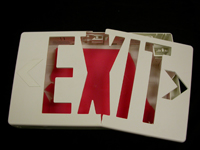
Electrical Exit Signs are made of plastic and are subject to damage & failure in commercial environments
Why is Photoluminescent (PL) Emergency Lighting Required?
- Failsafe operation; completely passive design
- PL emergency lighting is simple to install and requires no connection to an electrical circuit
- PL emergency lighting requires only occasional cleaning
- EverGlow PL emergency lighting has a long lifetime of greater than 25 years in interior installations
- Electricity outages are common
- EverGlow PL emergency lighting lasts meets code requirements for 90-120 minutes & continues to glow for many hours during power failures
- PL emergency lighting contains no battery, lamp or LED
- EverGlow PL emergency lighting consumes ZERO energy and contains ZERO radioactive, toxic or vinyl components

EverGlow Photoluminescent Exit Signs are made of aluminum and are durable, attractive, and long lasting
"Electrical (LED) exit signs have a service life of 5-10 years; Radioluminescent (tritium) exit signs last for 10, 15 or 20 years; Photoluminescent exit signs have an unlimited service life and consume no energy."
-US Department of Energy.
"Emergency lighting is the most neglected life safety component in most buildings."
-A manufacturer of emergency lighting
"... Due to high costs associated with testing emergency lighting, facilities actually will forgo the tests. ..."
-A Manufacturer of Electrical Emergency Lighting, in an Advertisement for a Central Monitoring & Testing System
"... Excluding healthcare and most government buildings, based on my experience I would estimate that more than 75% of the building owners/managers across the country are not testing their emergency lighting as mandated by the NFPA 101 Life Safety Code."
-A Code Consultant
Photoluminescent Emergency Lighting Code Requirements
- Non-electrical - because electrical emergency lighting too often fails to operate when it is needed most
- Reliable & Effective in all Emergency Conditions
- Works even when electrical, emergency & redundant electrical power fails
- Tested to the same Performance Standards as electrical emergency lighting
- Accepted and recommended by Life Safety, Fire Safety & Code Professionals
- Photoluminescent Exit Signs require a minimum of 5 ft-candles of illumination on the sign face
-
- -The amount of light required to read a newspaper held at arm length
- -UL 924 is the performance standard for (electrical & non-electrical) approved exit signs
- Photoluminescent (floor level) Exit Path Markings require a minimum of 1 ft-candle of illumination on the signs & markers
-
- The amount of light required to recognize a dollar bill on the floor
- UL 1994 is the performance standard for (electrical & non-electrical) approved floor level egress path marking systems
Recent Model Code Changes for Approved Exit Signs - IBC, IFC, NFPA 101. 2009.
Photoluminescent Emergency Lighting Requirements
- Reliable lighting source to properly charge the photoluminescent pigment
- Signs & markings must be properly charged while the building is occupied
- Signs & markings are charged with most ambient lighting sources, and sunlight
- Periodic inspections are needed to confirm lighting source(s) provide sufficient & proper lighting
- Inspections must also confirm that signs & markings are kept clean and are not damaged or missing
"BOMA - Building Owners & Managers Association - proposed allowing building owners who installed photoluminescent exit path markings (as proposed and accepted in 2009) to eliminate electrical emergency lighting. This proposal was not accepted."
-A Building & Fire Code Official
"A recent study by NRC (Canada), clearly showed that photoluminescent exit path markings could be used to evacuate high rise buildings as rapidly, effectively and safely as properly operating electrical emergency lighting."
-A Building & Fire Code Official
General Lighting - Building, Fire & Life Safety Code Requirements, OSHA & Safety Requirements, Ergonomic & Physical Comfort Requirements, Increased Complexity of Lighting Controls
- Normal Lighting - code required minimum lighting level in the means of egress during conditions of occupancy: 1 - 10 ft-candles of illumination at the floor or walking level
- Emergency Lighting - code required for 90 minutes, an average lighting level in the means of egress: 0.1 - 0.6 ft-candles of illumination at the floor or walking level
- Complete Darkness - complete failure of all electrical lights and emergency lighting systems is only addressed in the codes for high rise buildings and some amusement occupancies
- OSHA requires all exits to be clearly marked and properly illuminated
- Occupant Comfort - lighting levels in the corridors and stairs that are often used are generally kept at a minimum of 10-20 ft-candles of illumination at the floor or walking level
- Retailer Product Display - lighting levels in the showroom are often at least 40-60 ft-candles of illumination at floor level
- Office Lighting - lighting levels on the desktop is generally 30-50 ft-candles of illumination; any greater illumination and glare is a problem
- Lighting Controls, Occupancy Sensors, Dimmers - must default so that normal lighting levels are maintained if the controller or system fails; most evacuations occur in normal lighting conditions
- Lighting controls of any kind cannot be used with emergency lighting; nothing must compromise life safety during an emergency evacuation
EverGlow Photoluminescent Emergency Lighting is Green & Sustainable
- Signs & markings consume ZERO energy and contain ZERO radioactive, toxic or vinyl components
- Aluminum sign faces & frames contain ZERO mercury, lead or other heavy metals such as those found in lamps, batteries, LEDs and printed circuit boards
- Aluminum sign faces & frames contain at least 60% post-consumer recycled aluminum and can be recycled with other aluminum materials without any environmental restrictions
- 100% aluminum construction & long lasting coatings ensure a long service life - essentially "life of the building"
Cost of Energy & Maintenance of Electrical Emergency Lighting
Green Building design guidelines & requirements - LEED, ASHRAE, IGCC, California Title 24 - are changing the way we build and maintain facilities. New and renovated facilities will consume less energy, produce fewer greenhouse emissions, and reduce their entire environmental footprint.
Current requirements for greater energy efficiency are driving facility managers to consider both passive and active systems to reduce energy consumption for HVAC and lighting. Passive systems include better insulated walls and ceilings, fenestrations with less air infiltration, high performance glazings, and more efficient lighting. Active systems include HVAC and lighting system controls, and automatic window shades to control daylighting.
EverGlow applauds the use of lighting system controls to achieve greater energy efficiency and savings from electrical lighting. We believe that normal lighting can be safely dimmed from currently common illumination levels, that occupancy sensors can further reduce lighting costs in offices, and that daylighting can significantly improve the work environment and reduce energy consumption. These active, automatic systems must operate properly, be accepted by the occupants, and must be maintained properly.
We would like to remind building designers, owners & managers that the bulk of energy savings have come from passive systems used to build less drafty and better insulated facilities, window films and the use of lower wattage and more efficient lamps. Passive systems require very little maintenance. And, of course, more efficient lighting practices will likely change the load on HVAC systems and the energy these systems consume.
With the increased use of energy efficient, low mercury fluorescent lamps, the mercury levels in landfills is steadily increasing. Even efficient electrical lighting technology presents new risks to the environment. Many areas of the country also prohibit disposal of metal halide, high pressure sodium and mercury vapor lamps.
We caution building owners and facility managers against decreasing lighting illumination in exits and egress corridors, against severely reducing illumination below levels that occupants consider comfortable and safe for normal activities. We also encourage building owners to consider (passive, non-electrical) photoluminescent emergency lighting.
EverGlow suggests you Recycle Your Lighting - energy and dollars - and use photoluminescent emergency lighting to replace electrical exit signs where possible and practical. Photoluminescent exit signs absorb and store energy from your existing interior lighting and then glow when the normal lighting fails. You are never in the dark with EverGlow!
- Electricity costs average $0.12 per KWH and are expected to increase
- Electrical costs for general lighting and exit lighting are the same; but electrical lighting required in egress paths should NOT be switched off in response to load shedding requirements or "time of day" cost of energy
- Electrical connections for new installations average $150 or more and are expected to increase
- Maintenance expenses exceed $10 per hour and are expected to increase
- Fire & Life Safety system inspection costs are expected to increase
- Fines and other surcharges for failure to properly maintain fire & life safety systems are expected to increase
- Disposal costs of lead acid & nickel cadmium batteries are expected to increase
- Disposal costs of arsenic & lead in LED lighting may be on the horizon
"...it is NOT common practice at all to install an additional charging light source in order to provide 5 foot-candles of illumination on the face of a photoluminescent exit sign."
-EPA
ENERGY STAR - No Longer Certifies Energy Efficient Exit Signs
ENERGY STAR Certification for (electrical & non-electrical) Exit Signs has been Suspended by the US Department of Energy and US Environmental Protection Agency
- November 2007 - all manufacturers of exit signs informed that the ENERGY STAR specification for exit signs would be suspended, effective May 2008.
- Manufacturers of electrical exit signs requested this change because they were concerned that electrical exit signs might not be safe and effective if the energy consumption was driven to 5 watts per sign or less
- Requirements remain for electrical exit signs to draw no more than 5 watts per sign; there is no apparent loss of effectiveness
- EPA stated at the beginning of their program for exit signs that there are more than 100 million exit signs in the US, consuming 800,000 MW of electrical energy and costing $70 million each year to operate
- ENERGY STAR states that energy saving electrical exit signs will use LED lighting technology and MUST include a statement declaring, The light source in this sign will depreciate, which can lead to a light output level that is below current building code requirements. The light source (lamps) should be replaced at regular intervals, and when they are no longer functioning, to assure safety and visibility in the event of an emergency.
- DOE states that photoluminescent exit signs consume NO energy and have an unlimited service life
ENERGY STAR Requirements for Energy Efficient Exit Signs.
ENERGY STAR Announcement to Suspend Exit Sign Specification.
ENERGY STAR Savings Calculator for Different Exit Sign Technologies
NEMA Questions Claims of Energy Efficiency for Photoluminescent Exit Signs
NEMA - The National Electrical Manufacturers Association - is the primary trade association for the electrical product manufacturing industry. Its approximately 450 member companies manufacture products used in the generation, transmission and distribution, control, and end-use of electricity. NEMA promotes the competitiveness of the U.S. electrical product industry through the development of standards, advocacy in federal and state legislatures and executive agencies. NEMA's stated goal is to represent the industry's interests in new and developing technologies. There is no stated goal in NEMA's Vision or Mission Statements to promote public safety.
EverGlow has been prohibited from joining NEMA because we do not manufacture electrical lighting or other electrically powered products. In general, most manufacturers and suppliers of photoluminescent emergency lighting - exit signs, exit path markings, tapes and coatings that glow in the dark - are also refused membership in NEMA.
NEMA expressed their disagreement with UL, NFPA, ENERGY STAR, EPA, the Department of Energy, the FAA, the Department of Transportation, and other organizations over the use of photoluminescent emergency lighting - to supplement or replace electrical exit signs and other emergency lighting.
The NEMA website - About NEMA - Vision & Mission Statements.
NEMA - the Emergency Lighting Section.
The scope of the Emergency Lighting Section ... specifically includes all types of electrically illuminated exit and directional signs. Key governmental activities include advising and working with the Environmental Protection Agency on the Energy Star Exit Sign Program.
A general search for "photoluminescent" on the NEMA website produces these search results.
NEMA Publishes LSD 46-2009 Photoluminescent Exit Signage - Factual Review.
Exit Sign Visibility Testing and Requirements for Safety and Energy Efficiency.
"This standards publication contains performance requirements and test methods for evaluating exit sign visibility. Visibility requirements are based on an assumed normal visual acuity and normal color recognition in clear air at a maximum viewing distance of 30.5 m (100 ft). This scope does not imply that exit signs conforming to the requirements of this standard will be visible to all people under all environmental conditions." NEMA Emergency Lighting Section.
"The most efficient LED Exit Lights consume only 3 watts of energy per sign. ... If all of the more than 100 million exit signs in the US were upgraded to LED (electrical) lighting technology, they would all consume more than 2,000 GW-hr of energy each year. Although this is a substantial savings compared to less efficient (electrical) incandescent and fluorescent lighting used in older exit signs, this is the equivalent output from a very large electrical (coal or nuclear) generating station operating continually."
"Even the most energy efficient electrical lighting uses less energy when it is switched off."
-EPA
Comparison of Different Types of Emergency Lighting
Photoluminescent
- Tested to meet either the UL924 or UL1994 performance standards
- Consumes ZERO energy; operates for hours after the electricity fails
- EverGlow aluminum signs & markings contain ZERO radioactive, toxic or vinyl components
- Service life exceeds 25 years
- Virtually maintenance free - sign face must be kept clean
- 100% reliable operation, virtually failsafe
- Ambient lighting near the photoluminescent signs & markings must be maintained to provide minimum (charging) illumination
- Completely passive operation; required ambient lighting is often maintained more vigorously than emergency lighting
- Continually charging and discharging; proper operation is easy to detect in lit and darkened installations
- Glows to meet code requirements for a minimum of 90 minutes; continues to have a visible glow for many hours longer
- Visibility & legibility during lit and dark conditions depends on the contrast of the glowing EXIT and the background
- Exit signs be easily installed above the door and at floor level without additional requirements for ambient lighting
- Exit path markings can be easily installed at floor levels without additional electrical connections
- Ideal installation is in a clean, well-lit corridor or exit
Electrical
- Tested to meet either the UL924 or UL1994 performance standards
- Consumes 2-5 watts of energy per sign face
- Requires a reliable electrical supply to operate properly Contains heavy metals - lead or cadmium in the battery, mercury in the fluorescent lamp, arsenic in the LED,
- 3-5 year service life - lamps fail and are easy to detect; incandescent & fluorescent lamps fail and are easy to detect; LEDs dim long before failure and are not easy to detect; batteries can only be tested with load testing and it is more difficult to detect their failure
- Requires maintenance & replacement of batteries and LEDs (or lamps) every 1-3 years
- Reliable only if maintained properly
- Surveys have shown that electrical emergency lighting is NOT properly installed, maintained or operating in at least 10-20% of randomly chosen occupancies
- Increasingly complicated and maintenance intensive systems
- Batteries last only 90-120 minutes, if properly maintained; light dims significantly after 60 minutes
- Proper operation is easy to verify if test button or other recommended procedure is followed; actual condition of batteries is difficult to determine without load testing
- Ideal installation is in a facility that provides for required monthly and yearly testing
"ITM - Inspection, Testing & Maintenance:
- Inspection & Testing - code requires all emergency lighting systems be inspected & tested every month
- Those inspections and results must be recorded in a log and made available for the code inspector at all times
- Maintenance - Emergency lighting repairs must be made, and a record kept of those repairs
- It is NOT the code inspectors responsibility to perform these tests during his inspection"
"Most fines & penalties are generated by the failure of the building owner or facility manager to properly perform one or more of these requirements."
-A Building & Fire Code Official
Reliability & Effectiveness
The likelihood that emergency lighting will be available when it is needed and can perform as desired can be described by the product of reliability and effectiveness. One might disagree with the numerical value developed for reliability, or effectiveness, or both; but this method is a sound means of determining a baseline risk assessment for various life safety systems.
- Reliability is the probability that a lighting fixture will operate as designed and intended when needed
- Effectiveness is a measure of the adequacy of the lighting fixture once it is operating.
For instance, NFPA recently declared that the reliability and effectiveness of automatic sprinklers is as high as 91% for wet pipe systems. This factor was developed by multiplying the reliability, determined to be 95% in all sprinklered facilities, by the effectiveness, determined to be 96%. With this factor, NFPA estimates that, in buildings equipped with automatic sprinkler systems and for fires large enough to activate those sprinkler heads, sprinklers extinguished the fires in more than nine of ten fires. There can be no doubt that sprinklers increase life safety and reduce property damage. For more information, please review the NFPA reports developed on this subject.
There are no similar statistics developed for emergency lighting. However, a great deal of research has been done to evaluate the behavior of people trying to escape structures during emergency evacuations. There is agreement among fire & life safety officials and human behavior researchers that exits should be marked more clearly- so people can find the various exits available to them during an emergency, and so that once inside the exit they can proceed quickly and safely to a location away from the fire. Because of the time it takes for people to properly react to an emergency, move to and through the exits and finally exit a building, emergency lighting must provide guidance for the full 90 minutes required by code.
There are industry provided statistics for the reliability & effectiveness of emergency power supplies - generators supplying emergency power to maintain essential electrical equipment in hospitals and uninterruptable power supplies for data centers (UPS batteries, computer). Electrical emergency lighting systems contain lamps, batteries and control circuits. The LEDs (individual LEDs and arrays) in modern emergency lighting systems have proven to be very reliable and long lasting if provided with appropriate power supplies (not over driven) and heat sinks (to dissipate the heat generated by each LED). It is appropriate to assume that the LEDs in emergency lighting from a reputable manufacturer will provide greater reliability and trouble free service for 3-5 years after installation than incandescent or fluorescent lamps. The least reliable components in LED lighting is the emergency power supply - batteries or generators. For more information, please visit the links below.
Emergency Battery Supplies
- Lead acid batteries have a lifetime of 3-5 years until failure of at least one cell
- Deep cycling (significant discharge after an electrical power failure and the subsequent recharge) is a major cause of lead acid battery failure
- Nickel cadmium batteries have a lifetime of 3-5 years until the battery cannot hold sufficient charge for a 90 minute test
- NiCd batteries fail prematurely if not completely discharged and then recharged periodically
- Lead acid & NiCd batteries are the most mature battery technologies and, because of environmental concerns, likely to be phased out of use over the next 20 years
- Replacement technology, NiMH and Li-ion batteries, will improve reliability and reduce maintenance costs, but may require expensive upgrade or replacement of emergency lighting fixtures
Emergency Power Generators
- Failure to start (battery or cable failure)
- Fuel to the engine (lack of fuel supply, contaminated fuel, clogged fuel filters, fuel line failure)
- Failure of mechanical or control system components and automatic transfer switches
- Inappropriate testing or loading during testing
- Lack of maintenance
- A survey of 120 installed diesel generators revealed 5 failures during a year (failure during testing)
Electrical exit signs are not 100% reliable unless properly maintained and regularly tested
- Battery failure
- Lamp or LED failure; mechanical failure of connections
- LEDs dim to 70% of original lighting output (generally considered a useful lifetime of 3-6 years)
- Power supply or control system failure
- Failure to maintain or regularly test
- Surveys of installations in randomly chosen buildings show an average of 10-20% failure of at least one fixture (failure during testing)
Summary
- Reliability decreases with increasing complexity of an emergency lighting system
- Reliability of an electrical lighting system decreases rapidly with a lack of maintenance
- Reliability of an electrical lighting system depends on the reliability of the electricity supplier
- Effectiveness of a photoluminescent emergency lighting system component decreases with a lack of cleaning
- Effectiveness of all emergency lighting systems decreases with increasing smoke present during an emergency evacuation
- Effectiveness of floor level emergency lighting systems (exit signs & exit path markings) is greater than lighting located over the door as smoke fills an exit
Testing Emergency Lighting Systems, Consulting Specifying Engineer, April 2009.
US Experience with Sprinklers, NFPA, Marty Ahrens, July 2017.
Reliability of Automatic Sprinkler Systems, William Koffel, March 2004.
Restoring Reliability to Emergency Power Systems, FacilityNet, Tom Leinidas Jr, April 2006.
US Dept of Energy, Lifetime of White LEDs.
US Dept of Energy, LED Luminaire Reliability.
"The light source in this (electrical exit) sign will depreciate, which can lead to a light output level that is below current building code requirements. The light source (lamps or LEDs) should be replaced at regular intervals, and when they are no longer functioning, to assure safety and visibility in the event of an emergency."
"LED Exit Signs have a rated life of 50,000 hrs (until light output has dimmed to 70% of the initial output). This is a useful life of 5 or 6 years of continuous use. LED exit signs use approximately 44 KWh (kilowatt-hour) of electricity annually to operate."
-ENERGY STAR
"...Many (LED Exit Sign) products on the market today are utilizing power supplies that drive the LED circuit well past normal operating limits in order to pass UL luminance requirements. This practice will most certainly lead to a rapid depreciation of the LED light output available for normal operation."
-An Electrical Exit Sign Manufacturer
Performance Standards for Emergency Lighting
UL 924 - Emergency Power and Lighting Equipment
- All electrical & non-electrical exit signs and lights are tested to this standard and must meet minimum performance requirements at 90 minutes or battery power or in the dark (lights completely off)
- All approved exit signs & emergency lighting systems must meet this performance standard
- All listed internally & externally illuminated exit signs must meet this standard
- All listed exit signs installed above the door or at floor level must meet this standard
- Allows the manufacturer to decide whether to test illumination or legibility of the exit sign
- Requires exit sign batteries and photoluminescent exit signs to be fully discharged before beginning testing
- Allows up to 168 hrs for batteries to charge (or less, if specified by the manufacturer); up to 1 hr for photoluminescent signs to charge in the 5 ft-candles of charging light - certifies the visibility & legibility of all exit signs for 50, 75 or 100 ft viewing distance; these are distances likely to be encountered in most facilities
- Defines minimum light output (illumination) of electrical exit signs, sign retrofits & emergency lighting
- Minimum luminance for an exit sign is 8.57 cd/m2 on normal electrical power; 5.14 cd/m2 on battery or other emergency power; electrical signs meeting this requirement are listed at 100 ft visibility
- Minimum observation-visibility requirement is 50 ft; directional chevrons are tested for 40 ft visibility
Canada currently recognizes the Canadian standard, C860-07: Performance of Internally Lit Exit Signs. It is accepted as an alternative or supplementary performance requirement to UL924 (Canada). Canada considers electrical exit signs as internally illuminated; photoluminescent exit signs as externally illuminated. The US recognizes both electrical and photoluminescent exit signs as internally illuminated.
Recent Model Code Changes for Approved Exit Signs - IBC, IFC, NFPA 101. 2009.
UL 1994 - Luminous Egress Path Marking Systems
- All electrical & non-electrical exit path marking systems are tested to this standard
- All approved luminous exit egress path marking systems must meet this performance standard
- If intended and approved for use on stair nosings, all luminous stair markers must also meet the UL410 slip resistance performance standard
- All system components- signs & markers - must be visible and legible at a distance of 25 ft after 90 minutes in complete darkness
- Photoluminescent signs & markers are charged with 1 ft-candle of illumination for 1 hr in preparation for the observation-visibility test
- Emphasis is on the visibility of system components as necessary in most facilities
Building, Fire & Life Safety Codes currently allow the use of the ASTM E2072 (IBC, IFC) or ASTM E2073 (NFPA 101) standards for testing luminance of photoluminescent egress path marking system components. The luminance must be no less than 5 mcd/m2 after 1 hr charging with 1 ft-candle illumination and 90 minutes of discharge in complete darkness.
"UL 924 is the nationally recognized Standard for determining that an exit sign provides not only adequate protection from fire and electric shock, but also adequate visibility performance to meet the needs of the model building codes."
-Underwriters Laboratories
"1011.4 Internally Illuminated Exit Signs. Electrically powered, self-luminous and photoluminescent exit signs shall be listed and labeled in accordance with UL924 and shall be installed in accordance with the manufacturer's instructions and Section 2702."
-International Building Code - 2009
"7.10.7.1 Listing. Internally illuminated (exit) signs shall be listed in accordance with UL924, Standard for Emergency Lighting and Power Equipment..."
-NFPA 101 - 2009 (Life Safety Code)
A.3.3.126.2 Internally Illuminated. The light source is typically incandescent, fluorescent, LED, electroluminescent, photoluminescent or self-luminous."
-NFPA 101 -2006 (Annex A, Life Safety Code)
Performance in Smoke & Limited Visibility Evacuations
- Electrical and photoluminescent exit signs located above the door are obscured quickly by smoke collecting at the ceiling
- Brighter electrical exit signs are seen longer through smoke, unless they are so bright that the light reflects off the smoke (think of vehicle headlights reflecting off thick fog)
- IESNA - Illuminating Engineering Society of North America - reports that exit sign visibility is "critically affected by smoke or other light scattering particles (such as dust)"
- NIST (1990) research on visibility of exit signs in smoke: all electrical and non-electrical exit signs disappeared in 3.4 - 9.5 minutes
- NEMA (2001) sponsored research on exit sign brightness indicates that even though LED exit signs are approximately 100 times brighter than radioluminescent (radioactive tritium) exit signs and 1,000 times brighter than photoluminescent exit signs, they are NOT visible in smoke.
- Based on research and recommendations above, all exit signs located above the door are not likely to be seen if there is smoke or dust present during the evacuation
- Floor level emergency lighting- exit signs and exit path markings- are visible in smoke until the smoke reaches from the ceiling to the floor
- Breathable and relatively clear air are likely to found at floor level much longer if smoke is present during an evacuation
- Research in Norway found that if there is dense smoke at floor level, tactile (ADA type signs & markings) exit path marking systems were superior to any emergency lighting system
- NRC Canada (1999, 2006) research in clear air, comparing floor level photoluminescent exit path marking with electrical emergency lighting, found that continuous photoluminescent path marking provided the same evacuations times from high rise office buildings (using exit stairs) as electrical lighting
- Research in Norway (Heskestad, 1999) concluded that, in smoke filled evacuations, continuous photoluminescent exit path marking systems allowed people to evacuate as quickly as electrical exit path marking systems; note that most people resist evacuating through smoke filled exits
"Life safety depends on occupants being able to evacuate interior spaces in three lighting levels:
- normal lighting (all lighting is available)
- emergency lighting (normal electrical lighting has failed, only emergency lighting is available)
- complete darkness (the failure of all electrical lighting systems; only non-electrical emergency lighting is available)
"Most emergency evacuations occur in full (normal) lighting conditions. Normal lighting and safe evacuation conditions must not be compromised by the addition of lighting controllers, dimmers, timers, occupancy sensors or other energy saving devices."
-A Building & Fire Code Official
"Fire Tragedies are preventable only if all responsible parties comply with the applicable building safety requirements."
-A Building & Fire Code Official

